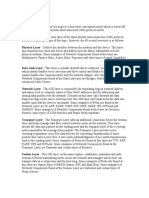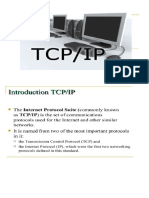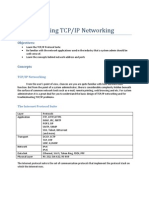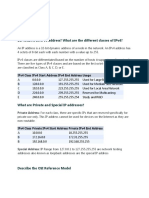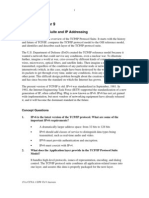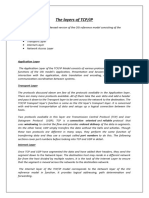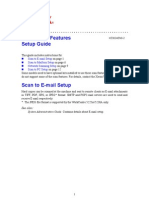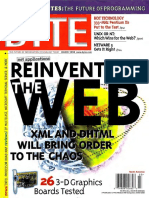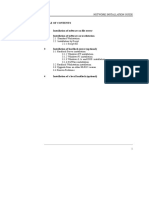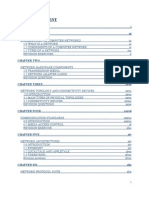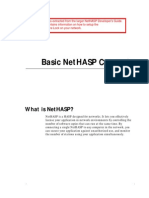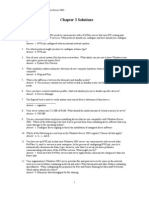0 ratings0% found this document useful (0 votes)
38 views4 - Local Area Network
4 - Local Area Network
Uploaded by
D'Bagas SaputraProtocols work by breaking data into packets, adding addressing information, and delivering packets over the network. The receiving computer performs the reverse by accepting packets, removing addressing, and reassembling the original data. Protocols that work together in layers are called a protocol stack or suite. Common protocol stacks include TCP/IP, IPX/SPX, and NetBEUI.
Copyright:
© All Rights Reserved
Available Formats
Download as PPT, PDF, TXT or read online from Scribd
4 - Local Area Network
4 - Local Area Network
Uploaded by
D'Bagas Saputra0 ratings0% found this document useful (0 votes)
38 views28 pagesProtocols work by breaking data into packets, adding addressing information, and delivering packets over the network. The receiving computer performs the reverse by accepting packets, removing addressing, and reassembling the original data. Protocols that work together in layers are called a protocol stack or suite. Common protocol stacks include TCP/IP, IPX/SPX, and NetBEUI.
Original Description:
lan
Original Title
4 . Local Area Network
Copyright
© © All Rights Reserved
Available Formats
PPT, PDF, TXT or read online from Scribd
Share this document
Did you find this document useful?
Is this content inappropriate?
Protocols work by breaking data into packets, adding addressing information, and delivering packets over the network. The receiving computer performs the reverse by accepting packets, removing addressing, and reassembling the original data. Protocols that work together in layers are called a protocol stack or suite. Common protocol stacks include TCP/IP, IPX/SPX, and NetBEUI.
Copyright:
© All Rights Reserved
Available Formats
Download as PPT, PDF, TXT or read online from Scribd
Download as ppt, pdf, or txt
0 ratings0% found this document useful (0 votes)
38 views28 pages4 - Local Area Network
4 - Local Area Network
Uploaded by
D'Bagas SaputraProtocols work by breaking data into packets, adding addressing information, and delivering packets over the network. The receiving computer performs the reverse by accepting packets, removing addressing, and reassembling the original data. Protocols that work together in layers are called a protocol stack or suite. Common protocol stacks include TCP/IP, IPX/SPX, and NetBEUI.
Copyright:
© All Rights Reserved
Available Formats
Download as PPT, PDF, TXT or read online from Scribd
Download as ppt, pdf, or txt
You are on page 1of 28
Chapter 4
Local Area Networks
4.1 Components & Technology
4.2 Access Technique
CSMA/CD
CSMA/CA
Token Passing
4.3 Transmission Protocol
NetBEUI
NwLink (IPX/SPX) suit
TCP/IP
4.4 Transmission Media.
There are protocols at various levels in the OSI
model. In fact, it is the protocols at a level in the OSI
model that provide the functionality of that level.
How protocols work –
A protocol is a set of basic steps that both parties (or
computers) must perform in the right order. For
instance, for one computer to send a message to
another computer, the first computer must perform
the following steps -
How protocols work
1. Break the data into small sections called ‘Packets’
2. Add addressing information to the packets identifying the
destination computer.
3. Deliver the data to the network card for transmission over
the network.
The receiving computer must perform the same steps, but in
reverse order :
1. Accept the data from the network adapter card.
2. Remove the transmitting information that was added by the
transmitting computer.
3. Reassemble the packets of data into the original message.
Protocol Stack
Protocols that work together to provide a layer or layers of
the OSI model are known as ‘Protocol Stack or Suit’. A
protocol stack (sometimes communications stack)
is a particular software implementation of a computer
networking protocol suite. The terms are often used
interchangeably. Strictly speaking, the suite is the
definition of the protocols, and the stack is the
software implementation of them.
The term stack also refers to the actual software that
processes the protocols. So, for example, programmers
sometimes talk about loading a stack, which means to
load the software required to use a specific set of
protocols. Another common phrase is binding a stack,
which refers to linking a set of network protocols to a
network interface card (NIC). Every NIC must have at
least one stack bound to it.
In Windows, the TCP/IP stack is implemented by the
Winsock DLL
Windows Socket, an API for
developing Windows programs that
can communicate with other
machines via the TCP/IP protocol.
Windows 95 and Windows NT comes
with Dynamic Link Library (DLL)
called winsock.dll that implements
the API and acts as the glue
between Windows programs and
TCP/IP connections.
ISDN's connection control protocol,
H.245 is a control channel protocol used with[in] e.g. H.323
and H.324 communication sessions, and involves the line
transmission of non-telephone signals. It also offers the
possibility to be tunneled within H.225.0 call signaling
messages. This eases firewall traversing.
The Real-time Transport Protocol (RTP), RTP Control
Protocol (RTCP), Remote Access Services (RAS)
Routing
The process of moving information from one LAN to
another over one or more paths between LANs is
called ‘routing’.
Protocols that support multipath LAN-to-LAN
communications are called ‘routable protocols.’
Microsoft – Supplied Network Protocol
Microsoft networking products come with three
network transports –
NetBEUI
NWLink
TCP/IP
NetBEUI is intended for small, single-server
networks.
NWLink is intended for medium-sized networks or for
networks that require access to Novell Netware file
servers.
TCP/IP is a complex transport sufficient for globe-
spanning networks such as the Internet.
NetBIOS Extended User Interface (NetBEUI) is a
protocol used primarily on small Windows NT networks.
NetBEUI is a simple protocol that lacks many of the
features that enable protocol suites such as TCP/IP to
be used on networks of almost any size.
NetBEUI was developed for workgroups of 2 to 200
computers. NetBEUI cannot be routed between
networks, so it is constrained to small local area
networks consisting of Microsoft and IBM clients &
servers.
A workgroup is Microsoft's terminology
for a peer-to-peer Windows computer
network.[1]
Microsoft operating systems in the same
workgroup may allow each other access to
their files, printers, or Internet connection.
Members of different workgroups on the
same local area network and TCP/IP
network can only access resources in
workgroups to which they are joined.
Workgroups can be used only if Microsoft
Network is enabled.
NetBEUI has a number of advantages including : -
High speed on small networks
Ability to handle more than 254 sessions
Ease of implementation
Good error protection
Self-tuning features
NetBEUI has these disadvantages : -
It cannot be routed between networks
There are few tools for NetBEUI such as protocol analyzers
It offers very little cross-platform support.
NWLink is Microsoft implementation of Novell’s
IPX/SPX Protocol Stack, used in Novell Netware.
NWLink is IPX for windows NT. IPX is the protocol,
NWLink is the network component that provides the
protocol.
(Novell Netware was one of the first commercial
Network operating system. Unlike Windows & Unix,
Netware is a dedicated client/Server operating system,
meaning that Netware servers contain no client
capabilities & Netware clients communicate only with
servers not with each other.)
To Provide transport services for the Netware Operating
system, Novell created its own suit of Protocols, usually
referred to by the name of network – layer protocol :
IPX or Internetwork Packet Exchange
As a parallel to TCP/IP, the suit is also sometimes called
IPX/SPX, which adds a reference to the Sequenced
Packet Exchange (SPX).
IPX/SPX is the network protocol used by Novell
Netware clients to connect to Netware servers. If your
network contains Netware servers, you may wish to use
this protocol.
IPX (Internetwork Packet Exchange)
Novell’s main network layer protocol is IPX. IPX
protocol is similar to IP. Both protocol use a
connectionless (Unreliable protocol at N/W layer)
services.
Like IP,IPX is responsible for addressing
datagrams & routing them to their destination on
other N/W.
IPX provides basic connectionless transport between
systems on an internetwork, it either broadcast or
unicast transmission. Most of the standard traffic
between Netware Servers & between Clients & servers
is carried with IPX datagram.
The header on an IPX datagram is 30 bytes.
SPX (Sequenced Packet Exchange)
SPX operates at the transport layer & provides a
connection-oriented, reliable service with flow control &
packet sequencing, much like TCP in the TCP/IP protocol
suit.
This protocol is concerned with addressing segment
development (division & combination), & connection
service (segment sequencing, error control & end-
to-end flow control.)
SPX provides connection-oriented packet delivery & is
used when IPX datagram packet delivery is not reliable
enough. Packet that arrive at their destination correctly
are acknowledged. If the receiving system does no
acknowledge the packet, that packet must be
retransmitted.
TCP/IP is the Transmission Control Protocol &
Internet Protocol, as well as a suite of related
protocols developed by the department of Defenses
Advanced Projects Research Agency.
TCP/IP is by far the most widely used protocol for
interconnecting computers & it is the protocol of the
Internet.
Advantages of TCP/IP include the following –
Broad connectivity among all types of computers &
servers.
Direct access to global Internet
Strong support for routing
Simple Network Management Protocol Support
(SNMP).
Support for most other Internet Protocol, such
as POP, HTTP, & so on.
If you have a network that spans more than one
metropolitan area, you will probably need to use
TCP/IP. It is routable over wide, complex networks
& provides more error correction than any other
protocol.
TCP/IP has some disadvantage –
Difficult to setup
Relatively high overhead to support seamless
connectivity & routing
Slower speed than IPX & NetBEUI
TCP/IP is the slowest of all the protocol included
with windows NT.
Media Access Control : -
The media access control (MAC) mechanism is one of
the protocol’s primary defining elements.
IEEE 802.11 defines the use of a MAC mechanism
called ‘Carrier Sense Multiple Access with
Collision Avoidance (CSMA/CA)’
The difference in CSMA/CD is that systems
attempt to avoid collisions in the first place by
reserving bandwidth in advance.
This is done by specifying a value in the Duration/ID
field or using specialized control messages called
‘request-to-send (RTS)’ & ‘Clear-to-send (CTS)’.
The carrier sense part of the transmission process
occurs on two levels, the physical & the virtual.
The Physical carrier sense mechanism is specific to the
physical – layer medium the network is using & is
equivalent to the carrier sense performed by Ethernet
systems.
The virtual carrier sense mechanism, called a ‘network
allocation vector’ (NAV) involves the transmission of an
RTS frame by the system with data to transmit, & a
response from the intended recipient in the form of a
CTS frame.
Both of these frames have a value in Duration/ID field
that specifies the amount of time needed for the
sender to transmit the forthcoming data frame and
receive an acknowledgement (ACK) frame in return.
This message exchange essentially reserves the
network medium for the life of this particular
transaction, which is where the collision avoidance
part of the mechanism comes in.
Since both the RTS & CTS(Request to Send / Clear
to Send) messages contain the Duration/ID field
value, any other system on the network receiving
either one of the two observes the reservation and
refrains from trying to transmit its own data during
that time interval.
In addition, the RTS/CTS exchange also enables a
station to more easily determine if communication
with the intended recipient is possible. If the sender of
an RTS frame fails to receive a CTS frame form the
recipient in return, it retransmits the RTS frame
repeatedly, until a pre-established timeout is reached.
Retransmitting the brief RTS message is much quicker
than retransmitting large data frames, which shortens
the entire process.
Token Ring is the traditional alternative to the Ethernet
protocol at the data-link layer. Token ring was originally
developed by IBM.
The biggest difference between Token Ring and Ethernet
is the Media Access Control mechanism. To transmit its
data, a workstation must be the holder of the ‘token’, a
special packet circulated to each node on the network in
turn. Only the system in possession of the token can
transmit, after which it passes the token to the next
system.
This eliminates all possibility of collisions in a properly
functioning network, as well as the need for a collision –
detection mechanism.
The nodes on a Token Ring network are connected in a
ring topology. Access to the network medium on a
token ring network is through the use of a 3byte packet
known as the ‘token’.
When the network is idle, the workstations are said to
be in ‘bit repeat mode’, awaiting an incoming
transmission. The token circulates continuously around
the ring, from node to node, until it reaches a
workstation that has data to transmit.
To transmit its data, the workstation modifies a single
‘monitor setting bit’ in the token to reflect that the
network is busy and sends it to the next workstation,
followed immediately by its data packet.
The packet also circulates around the ring. Each node
reads the destination address in the packet’s frame
header and either writes the packet to its memory buffer
for processing before transmitting it to the next node or
just transmits it without processing.
In this way, the packet reaches every node on the
network until it arrives back at the workstation that
originally sent it.
On the receipt of the packet after it has traversed the
ring, the sending node compares the incoming data with
the data it originally transmitted, to see if any errors have
occurred during transmission.
If error have occurred, the computer retransmits the
packet. If no errors have occurred, the computer
removes the packet from the network & discard it, &
then changes monitor setting bit back to its free
state & transmits it.
The process is then repeated with each system
having an equal chance to transmit.
You might also like
- Packet Sniffer Project DocumentDocument90 pagesPacket Sniffer Project DocumentAshish Katlam70% (10)
- Cisco Networking Academy Program. CCNA 3 and 4 Companion GuideDocument752 pagesCisco Networking Academy Program. CCNA 3 and 4 Companion GuideKatamba RogersNo ratings yet
- Netplus CheatsheetDocument15 pagesNetplus Cheatsheetworsham9915No ratings yet
- Leap Consys: User ManualDocument126 pagesLeap Consys: User ManualdapinminNo ratings yet
- Jason Zandri : TCP/IP Protocol Within Windows XP ProfessionalDocument29 pagesJason Zandri : TCP/IP Protocol Within Windows XP ProfessionalruvinduNo ratings yet
- Tcp/Ip: Understanding The Function of ProtocolsDocument10 pagesTcp/Ip: Understanding The Function of Protocolsapurb tewaryNo ratings yet
- TCP IP ModelDocument31 pagesTCP IP ModelJaveed AhamedNo ratings yet
- Network Layer Samia'Document10 pagesNetwork Layer Samia'Dark GardianNo ratings yet
- NetworksDocument3 pagesNetworksjisskuruvillaNo ratings yet
- Novell NetwareDocument6 pagesNovell NetwareVenkata Ganesh Gorla0% (1)
- Computer Networks TCP IpDocument15 pagesComputer Networks TCP IpSudarshan KrishnaNo ratings yet
- Osi and ProtocolsDocument7 pagesOsi and ProtocolsGilgamesh berserkerNo ratings yet
- Cisco Certified Network Associate (CCNA) and Cisco Certified Network Professional (CCNP): Mastering Network Automation and Programmability Study GuideFrom EverandCisco Certified Network Associate (CCNA) and Cisco Certified Network Professional (CCNP): Mastering Network Automation and Programmability Study GuideNo ratings yet
- Chapter 5-2 - LAN Software ArchitectureDocument23 pagesChapter 5-2 - LAN Software ArchitectureAfendey ArthurNo ratings yet
- g12 Css 1st QTR SLM - EdfDocument64 pagesg12 Css 1st QTR SLM - EdfYaj AnilomNo ratings yet
- PM NW Ccna Day 4 NotesDocument10 pagesPM NW Ccna Day 4 NotesRiyaz AdminNo ratings yet
- Abstract On Socket ProgrammingDocument33 pagesAbstract On Socket Programmingyogesh_yadav2012100% (2)
- Network Protocols: Lecturer SlidesDocument33 pagesNetwork Protocols: Lecturer SlidesevhyajahNo ratings yet
- Resume Instalasi Lan (Pengertian Jaringan)Document8 pagesResume Instalasi Lan (Pengertian Jaringan)Rahmat NugrahaNo ratings yet
- 1.1: Networking Theory & Java Overview: Prepared By: Siti Nur Ain FTK 2016Document38 pages1.1: Networking Theory & Java Overview: Prepared By: Siti Nur Ain FTK 2016ainnNo ratings yet
- CH 05Document10 pagesCH 05Hari PrasadNo ratings yet
- G12 - CSS - 1ST QTR - SLM - Edf PDFDocument105 pagesG12 - CSS - 1ST QTR - SLM - Edf PDFBonus MaribelNo ratings yet
- DC Module1 2Document13 pagesDC Module1 2pbayanagNo ratings yet
- Chapter TwoDocument71 pagesChapter TwoyaNo ratings yet
- Tell Me Something About VPN (Virtual Private Network) : Below Are Few Advantages of Using VPNDocument7 pagesTell Me Something About VPN (Virtual Private Network) : Below Are Few Advantages of Using VPNgolu23_1988No ratings yet
- unit 3.5Document28 pagesunit 3.5say.talekarNo ratings yet
- OSI ModelDocument33 pagesOSI Modelhadirehman488No ratings yet
- Key Architectural PrinciplesDocument9 pagesKey Architectural Principlesablog165No ratings yet
- Learn more about the TCP IP modelDocument4 pagesLearn more about the TCP IP modeljajamsrinuNo ratings yet
- The Internet Protocol SuiteDocument5 pagesThe Internet Protocol SuiteErwinMacaraigNo ratings yet
- Computer Networks:: OSI Reference ModelDocument11 pagesComputer Networks:: OSI Reference ModelMasterNo ratings yet
- Transmission Control Protocol/Internet Protocol (TCP/IP)Document10 pagesTransmission Control Protocol/Internet Protocol (TCP/IP)Sanjoy Basak100% (1)
- Subnet Masks: Internet Protocol (IP) Defines How Network Data Is Addressed From A Source To ADocument14 pagesSubnet Masks: Internet Protocol (IP) Defines How Network Data Is Addressed From A Source To AsunitamohindrooNo ratings yet
- TCP IP ApplicationsDocument10 pagesTCP IP ApplicationsJetesh DevgunNo ratings yet
- Unit VDocument33 pagesUnit VErwin VunguNo ratings yet
- OSI Model:: Application CiscoDocument16 pagesOSI Model:: Application CiscoHAINHDT2No ratings yet
- Advanced Computer Networks - CoSc-6111-Lecture-4Document80 pagesAdvanced Computer Networks - CoSc-6111-Lecture-4AhmedNo ratings yet
- Chapter3-Network Basics in CCDocument24 pagesChapter3-Network Basics in CChaithamokour11No ratings yet
- Network Communication ProtocolsDocument111 pagesNetwork Communication ProtocolsignatvaseaNo ratings yet
- DC and CN Chapt-4-1Document98 pagesDC and CN Chapt-4-1habtamud655No ratings yet
- What Is An Ipv4 Address? What Are The Different Classes of Ipv4?Document30 pagesWhat Is An Ipv4 Address? What Are The Different Classes of Ipv4?Sarkari Job and Exam ResultsNo ratings yet
- Unit 1Document54 pagesUnit 1AngayarkanniNo ratings yet
- OSI Layers and Network Design: Susan J. FagerDocument6 pagesOSI Layers and Network Design: Susan J. FagerramachandraNo ratings yet
- Computer Networks and Internet: SubtitleDocument32 pagesComputer Networks and Internet: SubtitleKhanh Hung100% (1)
- Physical Layer Data Link Layer: Logical Link Control (LLC) Media Access Control (MAC)Document44 pagesPhysical Layer Data Link Layer: Logical Link Control (LLC) Media Access Control (MAC)GauravNo ratings yet
- OSI Reference ModelDocument6 pagesOSI Reference ModelccnpcorvitNo ratings yet
- CMPN 370 - Handout 3.5 Protocol Suites - TCP/IP: Application LayerDocument5 pagesCMPN 370 - Handout 3.5 Protocol Suites - TCP/IP: Application LayerShania LallNo ratings yet
- Define Communication, Write The Feature & Component of CommunicationDocument5 pagesDefine Communication, Write The Feature & Component of CommunicationAbu SayedNo ratings yet
- PDF DocumentDocument5 pagesPDF DocumentBritney PitttersonNo ratings yet
- Unit Iv-1Document33 pagesUnit Iv-1InnocentNo ratings yet
- Csi 04Document32 pagesCsi 04lanh99635No ratings yet
- COMPABCA30730YComYAP - Assignment2 - 20BCA23@agu - Edu.in - Ass 2 (CN)Document6 pagesCOMPABCA30730YComYAP - Assignment2 - 20BCA23@agu - Edu.in - Ass 2 (CN)Tashi BhutiaNo ratings yet
- Unit 4 Transport LayerDocument9 pagesUnit 4 Transport LayerB4 BooksNo ratings yet
- 151x Ccna 1 Ejw CH 9 AnswersDocument12 pages151x Ccna 1 Ejw CH 9 Answersapi-3842231100% (3)
- IncredibleDocument2 pagesIncredibleDemixNo ratings yet
- The Layers of TCPDocument2 pagesThe Layers of TCPNaveen RecizNo ratings yet
- Comp NetworkingDocument8 pagesComp NetworkinghazzaarshadshaikhNo ratings yet
- Network Basics 1.1 What Is A Network?Document115 pagesNetwork Basics 1.1 What Is A Network?santhoshmayal_460311No ratings yet
- Cyber Security Module 1 Lesson 1 NotesDocument11 pagesCyber Security Module 1 Lesson 1 NotesAnshpreet SinghNo ratings yet
- CN 1Document7 pagesCN 1T024KOUSTAV CHATTERJEENo ratings yet
- CompTIA Network+ (N10-009) Study Guide: Comprehensive Exam Preparation and Key Concepts for Network ProfessionalsFrom EverandCompTIA Network+ (N10-009) Study Guide: Comprehensive Exam Preparation and Key Concepts for Network ProfessionalsNo ratings yet
- MSRT-UL-English Neutral User Manual-192321122002004Document18 pagesMSRT-UL-English Neutral User Manual-192321122002004Abdelwhab ElsaftyNo ratings yet
- 1993-05 The Computer Paper - Ontario EditionDocument48 pages1993-05 The Computer Paper - Ontario EditionthecomputerpaperNo ratings yet
- Cit854 Summary Note - CompleteDocument36 pagesCit854 Summary Note - CompleteEMMANUELNo ratings yet
- Technology Proof of ConceptDocument21 pagesTechnology Proof of ConceptrobinNo ratings yet
- CommVault Express 80 DatasheetDocument4 pagesCommVault Express 80 DatasheetjorgeflhNo ratings yet
- Smart UPS BrochureDocument20 pagesSmart UPS BrochureSfirloaga IonNo ratings yet
- Uc 3 Setup Computer Server FinalDocument100 pagesUc 3 Setup Computer Server FinalJsmjc IDNo ratings yet
- Startup Guide: Includes: Enterprise Console 1.0 EM Library 1.2 Sophos Anti-VirusDocument97 pagesStartup Guide: Includes: Enterprise Console 1.0 EM Library 1.2 Sophos Anti-VirusSampath MuthunayakeNo ratings yet
- Workcentre 7232 PDFDocument236 pagesWorkcentre 7232 PDFPreduta MonicaNo ratings yet
- Oce AutoCad ReferenceDocument3 pagesOce AutoCad ReferenceLoraine Lipalam Juanitas50% (2)
- Persuasive Essay Domestic ViolenceDocument4 pagesPersuasive Essay Domestic Violenceafhbgmmtc100% (2)
- Novell JLDAPDocument42 pagesNovell JLDAPradulaurentiuNo ratings yet
- Service Guide: Canon U.S.A., Inc. Rev. 0 Technical Support Division March 1999Document41 pagesService Guide: Canon U.S.A., Inc. Rev. 0 Technical Support Division March 1999COPIMASE COPIADORAS MATERIALES Y SERVICIOSNo ratings yet
- Quick Scan Features Setup GuideDocument14 pagesQuick Scan Features Setup GuideNelly Torres CruzNo ratings yet
- Toshiba Scanning GuideDocument116 pagesToshiba Scanning GuideAmin KaeidiNo ratings yet
- DFS Technical RefferenceDocument59 pagesDFS Technical Refferenceapi-3716933No ratings yet
- Ablerex MS-RT User ManualDocument18 pagesAblerex MS-RT User Manualgrecu0No ratings yet
- Byte Magazine Vol 23-03 Reinventing The WebDocument188 pagesByte Magazine Vol 23-03 Reinventing The WebMartin ChipilukNo ratings yet
- Fluke 68X LanmeterDocument12 pagesFluke 68X LanmeterGeorge MorrisNo ratings yet
- 1 Installation of Software On File Server 2 Installation of Software On WorkstationDocument13 pages1 Installation of Software On File Server 2 Installation of Software On WorkstationIek ORlandoNo ratings yet
- Manul de Instructiuni UPSDocument94 pagesManul de Instructiuni UPSAnastasia AlexandraNo ratings yet
- Novell NetwareDocument37 pagesNovell NetwareVijeshNo ratings yet
- Ibm Ds8000 CliDocument669 pagesIbm Ds8000 CligodisdeadNo ratings yet
- Networking EssentialsDocument88 pagesNetworking EssentialsCharles Nyaga MubiaxNo ratings yet
- Manual de Instalação e Configuração Ctree ServerDocument128 pagesManual de Instalação e Configuração Ctree ServerEliandro CardosoNo ratings yet
- NethaspDocument43 pagesNethaspdeus_7No ratings yet
- Chapter 3 Solutions: Review QuestionsDocument2 pagesChapter 3 Solutions: Review Questionsapi-3729297No ratings yet






